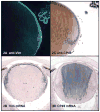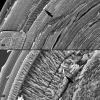Lens intermediate filaments
- PMID: 19071112
- PMCID: PMC2696462
- DOI: 10.1016/j.exer.2008.11.007
Lens intermediate filaments
Abstract
The ocular lens assembles two separate intermediate filament systems sequentially with differentiation. Canonical 8-11 nm IFs composed of Vimentin are assembled in lens epithelial cells and younger fiber cells, while the fiber cell-specific beaded filaments are switched on as fiber cell elongation initiates. Some of the key features of both filament systems are reviewed.
Figures




Similar articles
-
Development- and differentiation-dependent reorganization of intermediate filaments in fiber cells.Invest Ophthalmol Vis Sci. 2001 Mar;42(3):735-42. Invest Ophthalmol Vis Sci. 2001. PMID: 11222535
-
The beaded intermediate filaments and their potential functions in eye lens.Bioessays. 1994 Jun;16(6):413-8. doi: 10.1002/bies.950160609. Bioessays. 1994. PMID: 8080431 Review.
-
Filensin and phakinin form a novel type of beaded intermediate filaments and coassemble de novo in cultured cells.J Cell Biol. 1996 Feb;132(4):643-55. doi: 10.1083/jcb.132.4.643. J Cell Biol. 1996. PMID: 8647895 Free PMC article.
-
Periplakin interactions with lens intermediate and beaded filaments.Invest Ophthalmol Vis Sci. 2009 Mar;50(3):1283-9. doi: 10.1167/iovs.08-2894. Epub 2008 Nov 21. Invest Ophthalmol Vis Sci. 2009. PMID: 19029034 Free PMC article.
-
Seeing is believing! The optical properties of the eye lens are dependent upon a functional intermediate filament cytoskeleton.Exp Cell Res. 2005 Apr 15;305(1):1-9. doi: 10.1016/j.yexcr.2004.11.021. Epub 2005 Jan 26. Exp Cell Res. 2005. PMID: 15777782 Review.
Cited by
-
Role of Aquaporin 0 in lens biomechanics.Biochem Biophys Res Commun. 2015 Jul 10;462(4):339-45. doi: 10.1016/j.bbrc.2015.04.138. Epub 2015 May 8. Biochem Biophys Res Commun. 2015. PMID: 25960294 Free PMC article.
-
Localization of the lens intermediate filament switch by imaging mass spectrometry.Exp Eye Res. 2020 Sep;198:108134. doi: 10.1016/j.exer.2020.108134. Epub 2020 Jul 16. Exp Eye Res. 2020. PMID: 32682822 Free PMC article.
-
Ultrastructural analysis of the human lens fiber cell remodeling zone and the initiation of cellular compaction.Exp Eye Res. 2013 Nov;116:411-8. doi: 10.1016/j.exer.2013.10.015. Epub 2013 Oct 30. Exp Eye Res. 2013. PMID: 24183661 Free PMC article.
-
Lens Biology and Biochemistry.Prog Mol Biol Transl Sci. 2015;134:169-201. doi: 10.1016/bs.pmbts.2015.04.007. Epub 2015 Jun 4. Prog Mol Biol Transl Sci. 2015. PMID: 26310155 Free PMC article. Review.
-
CD24 is required for sustained transparency of the adult lens.Exp Eye Res. 2025 Jun;255:110347. doi: 10.1016/j.exer.2025.110347. Epub 2025 Mar 18. Exp Eye Res. 2025. PMID: 40112946
References
-
- Achstatter T, Moll R, et al. Expression of glial filament protein (GFP) in nerve sheaths and non-neural cells re-examined using monoclonal antibodies, with special emphasis on the co-expression of GFP and cytokeratins in epithelial cells of human salivary gland and pleomorphic adenomas. Differentiation. 1986;31(3):206–27. - PubMed
-
- Agbulut O, Li Z, et al. Analysis of skeletal and cardiac muscle from desmin knock-out and normal mice by high resolution separation of myosin heavy-chain isoforms. Biol Cell. 1996;88(3):131–5. - PubMed
-
- Albers K, Fuchs E. The molecular biology of intermediate filament proteins. Int Rev Cytol. 1992;134:243–79. - PubMed
-
- Alizadeh A, Clark J, et al. Targeted deletion of the lens fiber cell-specific intermediate filament protein filensin. Invest Ophthalmol Vis Sci. 2003;44(12):5252–8. - PubMed
-
- Alizadeh A, Clark J, et al. Characterization of a mutation in the lens-specific CP49 in the 129 strain of mouse. Invest Ophthalmol Vis Sci. 2004;45(3):884–91. - PubMed
Publication types
MeSH terms
Substances
Grants and funding
LinkOut - more resources
Full Text Sources

